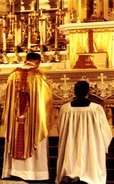Taken from Closed Cafeteria
The question "people's altar or high altar" has become a reason for dispute. A Viennese parish decided, to once more celebrate Mass using the baroque high altar. A movable people's altar will only be used for "family Masses". Someone told the media about this which resulted in some clamoring, including the hilarious statement that from now on the priest would "preach to the wall" in this church!
First and foremost: It is not decisive in which direction the celebrant faces, but rather what happens on the altar. We are called to focus on the "mystery of faith", on Christ who is in our midst, whose dedication to the Father, for us and for all people we celebrate in the Eucharist. We proclaim His death and His resurrection because they become present among us. That is the center and the source and the highpoint of the Christian life, as the Council stated several times. So this question arises on occasion of this "altar controversy" - are we sufficiently aware of this ?
Second: Both directions of celebration are justified and neither should be suspected or "ideologized" . Mass isn't celebrated "to the people" or "to the wall", but to God through Jesus Christ in the Holy Spirit. The celebration turned "to the people" has the meaning that we all, priests and laypeople, gather around Christ who symbolizes the altar and whose Body and Blood become present on the altar. The celebration "with the back to the people" is not a turning away from the faithful but facing in the same direction in prayer, expression of the path we walk walk towards God as pilgrims, His wandering people.
Third: Vatican II did not say anything about the direction of the celebrant. It wasn't until 1969 that the GIRM said (Nr. 262): "The main altar should be built separated from the wall, so that it can be walked around easily to make the celebration versus populum (towards the people)" In the 2002 edition the following is added: "This should be the case wherever it is possible". The Roman Congregation has declared this as a recommendation, not a requirement.
Fourth: The oldest direction for prayer is towards the East. The Jews prayed towards Jerusalem, the Muslims towards Mecca, the Christians towards the rising sun which symbolizes the Risen Christ. Thus the respective orientation of the synagogues, mosques and churches. The orientation, ie the "Eastwardness" of churches is one of the "original laws" of church architecture. St. Peter's in Rome faces westward for practical reasons. therefore the Pope celebrates facing the doors, which are in the East, and because of that towards the people. It is good to remind oneself what "orientation" means.
Lastly, a personal comment: I love both directions of celebrating Mass. Both are full of meaning for me. Both help me to encounter Christ - and that is, after all, the purpose of the liturgy.
Subscribe to:
Post Comments (Atom)



No comments:
Post a Comment